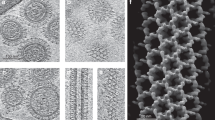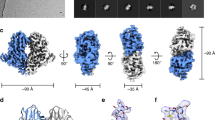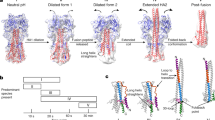Abstract
INSIGHT into the molecular organization of cellular membranes may be gained by defining their molecular components in terms of functional groups which serve as receptors for virus attachment. Thus, the specific attachment of myxovirus to neuraminic acid-terminating glyco-protein groups on the cell surface and the loss of virus binding capacity following exposure of cells to neuraminidase serve to define the neuraminic acid molecule in its role as a functional receptor on the plasma membrane1. This report describes the first use of this approach to map the surface of nuclei by comparing the characteristics of myxovirus attachment and elution of whole cells with isolated nuclei. Here we demonstrate that the surface of cytoplasm-free nuclei prepared by treating cells with an anionic detergent contains specific receptors for the attachment of myxovirus, and that in terms of viral adsorption and elution the surface of nuclei isolated from HeLa cells reacts much like that of an erythrocyte, or of a host cell the viral engulfment capacity of which has boon destroyed by heat.
This is a preview of subscription content, access via your institution
Access options
Subscribe to this journal
Receive 51 print issues and online access
$199.00 per year
only $3.90 per issue
Buy this article
- Purchase on Springer Link
- Instant access to full article PDF
Prices may be subject to local taxes which are calculated during checkout
Similar content being viewed by others
References
Gottschalk, A., in The Viruses, IV, edit. by Burnet. F. M., and Stanley, W. M., 3 (Academic Press, 1959).
Mandel, B., Virology, 17, 288 (1962).
Hodes, M. E., Palmer, C. G., and Williams, D. S., Nature, 182, 529 (1958).
Fisher, H. W., and Harris, H., Proc. Roy. Soc., B, 156, 521 (1962).
Hubert, M. T., Favard, P., Carasso, N., Rosencwajg, R., and Zalta, J., J. de Microscopie, 1, 435 (1962).
Hymer, W. C., and Kuff, E. L., J. Histochem. Cytochem., 12, 359 (1964).
Marcus, P. I., and Carver, D. H., Science, 149, 938 (1965).
Robbins, E., and Marcus, P. I., J. Cell. Biol., 18, 237 (1963).
Klenk, E., and Lempfrid, H., Hoppe-Seyl. Z., 307, 278 (1957), quoted by Cohen, A., in Mechanisms of Virus Infection, chap. 4, edit. by Smith, W. (Academic Press, 1963).
Howe, C., Rose, H. M., and Schneider, L., Proc. Soc. Exp. Biol. and Med., 96, 88 (1957).
Marcus, P. I., Virology, 9, 546 (1959).
Tolmach, L. J., in Advances in Virus Research, 4, 67 (1957).
Marcus, P. I., Bact. Rev., 23, 232 (1957).
Silverstein, S. C., and Marcus, P. I., Virology, 23, 370 (1964).
Warren, L., J. Biol. Chem., 234, 1971 (1959).
Burnet, F. M., in Principles of Animal Virology, second ed., 114 (Academic Press, 1960).
Wallach, D. F. H., and Eylar, E. H., Biochim. Biophys. Acta, 52, 549 (1961).
Marcus, P. I., and Hirsh, D., (abst., J. Cell. Biol.), 19, 47A (1963).
Author information
Authors and Affiliations
Rights and permissions
About this article
Cite this article
MARCUS, P., SALB, J. & SCHWARTZ, V. Nuclear Surface N-Acetyl Neuraminic Acid Terminating Receptors for Myxovirus Attachment. Nature 208, 1122–1124 (1965). https://doi.org/10.1038/2081122b0
Issue Date:
DOI: https://doi.org/10.1038/2081122b0
This article is cited by
-
Cell receptors for paramyxoviruses
Archives of Virology (1977)
-
The role of the cell surface in the mechanism of the action of antineoplastic drugs (literature survey)
Pharmaceutical Chemistry Journal (1977)
-
Nuclear Pore Complexes: “Press-Stud” Elements of Chromosomes in Pairing and Control
Nature New Biology (1972)
-
Studies on the role of myxovirus neuraminidase in virus-cell receptor interaction by means of direct determination of sialic acid split from cells
Archiv f�r die gesamte Virusforschung (1970)
-
Analyse des Zellcyclus, Bestimmung des Trockengewichtes und des DNS-Gehaltes der HeLa-Zellen
Virchows Archiv B Cell Pathology (1969)
Comments
By submitting a comment you agree to abide by our Terms and Community Guidelines. If you find something abusive or that does not comply with our terms or guidelines please flag it as inappropriate.



